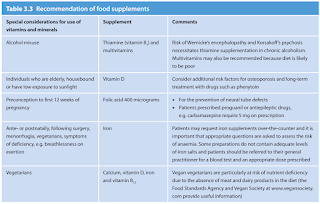Vitamin Supplementation
Introduction
Vitamins are chemically unrelated families of organic compounds that are essential in small amounts for normal metabolism. Because vitamins (with the exception of vitamin D3, vitamin K2 and B12) cannot be synthesized by humans, they need to be ingested in the diet to prevent disorders of metabolism.
Despite concerns over indiscriminate use of certain vitamins, it is clear that special groups benefit from and indeed require vitamin and mineral supplementation.
However, the role of vitamin supplementation in prevention or reversal of many chronic diseases is less well established.
Vitamin Deficiency
Gross vitamin deficiency may be recognized by obvious clinical syndromes.
Clinical situations in which vitamin deficiency syndromes occur:
- Poor intake - Poverty, older adults, alcoholics, restrictive diets (e.g., vegan)
- Malabsorption - Celiac disease, Crohn disease, short bowel, gastric bypass, older adults
- Abnormal losses - Haemodialysis, chronic diarrhoea
- Abnormal metabolism - Genetic polymorphisms, alcoholism (increases folate metabolism)
- Inadequate synthesis - Vitamin D (Homebound, little exposed skin)
Dietary Reference Intakes (DRIs)
There are several ways of defining optimal vitamin intake. Dietary reference intakes (DRIs) represent 4 concepts.
- Recommended Dietary Allowance (RDA)
- Adequate Intake (AI)
- Estimated Average Requirement (EAR)
- Tolerable Upper Intake Level
For clinical purposes, RDA is the average daily intake that is sufficient to meet the dietary requirement of nearly all healthy people.
Folic Acid
Folic acid has been studied for prevention of many disease states. However, the only well-established benefit of folic acid supplementation is the prevention of neural tube defects.
- Efficacy of homocysteine-lowering therapy with folic acid in stroke prevention: a meta-analysis, 2010
- Meta-analysis of folic acid supplementation trials on risk of cardiovascular disease and risk interaction with baseline homocysteine levels, 2010
Excess folate intake (approximately twice the recommended dose) has been associated with peripheral neuropathy, despite normal serum levels of vitamin B12, in older individuals who have a common polymorphism in the transcobalamin vitamin B-12 transporter gene.
Vitamin D
Subclinical vitamin D deficiency or insufficiency is extremely common and may contribute to the development of osteoporosis, falls, and fractures in older adults.
- The Recommended Dietary Allowance (RDA) of vitamin D for children 1 to 18 years, pregnant women, and nonpregnant adults through age 70 years is 600 IU, with the RDA increasing to 800 IU after age 70 years.
Antioxidant Vitamins
The antioxidant vitamins include vitamin A (consisting of preformed vitamin A, or retinol, and the carotenoids such as beta-carotene) as well as vitamins C and E.
Randomized trials evaluating antioxidant supplements have not found a reduction the risk of cancer or cardiovascular disease.
- Relation of consumption of vitamin E, vitamin C, and carotenoids to risk for stroke among men in the United States, 1999
- Use of antioxidant vitamins for the prevention of cardiovascular disease: meta-analysis of randomised trials, 2003
- Antioxidant supplements for prevention of gastrointestinal cancers: a systematic review and meta-analysis, 2004
- Effects of vitamin E on stroke subtypes: meta-analysis of randomised controlled trials, 2010
Multivitamin
Most generic and brand-name multivitamins contain 50 to 150 percent of the Recommended Dietary Allowance (RDA) for all vitamins, including folic acid and vitamins A, C, D, E, B2, B6, and B12.
- However, there are several variations of multivitamins, such as B vitamins alone, multivitamins with minerals, and multivitamins for specific groups (e.g., females, males, younger and older populations).
Multivitamin supplementation should be considered for patients at risk for vitamin deficiency, such as those with alcohol use disorder, poor-quality diets with low fruit and vegetable intake, malabsorption, a vegan diet, a history of bariatric surgery, or some inborn errors of metabolism, as well as those being treated with haemodialysis or parenteral nutrition.
Unless there is specific indication, UpToDate do not suggest multivitamin supplementation for primary prevention of chronic diseases in people with adequate dietary intake because of insufficient evidence of effectiveness.
- However, many patients wish to take multivitamins based on their own belief systems; UpToDate advises that clinicians not struggle against that practice as long as there is no absolute contraindication for an individual patient.
Toxicity at High Doses
The Institute of Medicine (IOM) and the Office of Dietary Supplements has suggested Tolerable Upper Intake Levels for specific vitamins, which is the highest daily dose that is unlikely to cause adverse health effects in the general population.
Concerns
- Acute vitamin A toxicity occurs in adults when a single dose of >660000 units (>200 mg) of vitamin A is ingested. Symptoms include nausea, vomiting, vertigo and blurry vision.
- Chronic toxicity occurs with long-term ingestion of vitamin A doses in amounts higher than 10 times the RDA. Signs of chronic toxicity may include ataxia, alopecia, hyperlipidemia, hepatotoxicity, bone and bone muscle pain, visual impairments, hypercalcemia (rarely), and many other nonspecific signs and symptoms.
- Vitamin A in pregnancy is teratogenic at doses as low as several times the RDA [with an apparent threshold at 10,000 units/day (approximately 3000 micrograms) of supplemental vitamin A].
- Beta-carotene appears to increase the risk of lung cancer in adults who are otherwise at high risk because of smoking or exposure to asbestos.
- Cases of peripheral neuropathy, dermatoses, photosensitivity, dizziness, and nausea have been reported with long-term megadoses of vitamin B6 (pyridoxine) over 250 mg/day; a few cases of neuropathy appear to have been caused by chronic intake of 100 to 200 mg/day.
- Large doses of vitamin C (in gram quantities) have been associated with diarrhoea and abdominal bloating. Epidemiologic data have shown a correlation between dietary and supplemental vitamin C intake and oxalate kidney stones in men, especially at very high doses.
- Vitamin D may cause hypercalcemia at doses as low as 4000 units/day (recommended upper limit) in some people. Symptoms of acute intoxication are due to hypercalcemia and include confusion, polyuria, polydipsia, anorexia, vomiting, and muscle weakness. Chronic intoxication may cause nephrocalcinosis, bone demineralization, and pain.
- There are concerns that vitamin E supplementation above 400 units per day (270 mg/day RRR-alpha tocopherol) may be associated with increased all-cause mortality.
External Links
- UpToDate - Vitamin Supplementation in Disease Prevention
- Oregon State University - Vitamins
- The safety of commonly used vitamins and minerals, 2021
- How much vitamin B6 is toxic?, 2005
- Antioxidant supplements for prevention of mortality in healthy participants and patients with various diseases, 2012
- Enough is Enough: Stop Wasting Money on Vitamin and Mineral Supplements, 2013
- Is There Really Any Benefit to Multivitamins?, 2017
- Do Multivitamins Make You Healthier?, 2019
- Health supplements containing vitamin B6 can cause peripheral neuropathy, 2022





Comments
Post a Comment